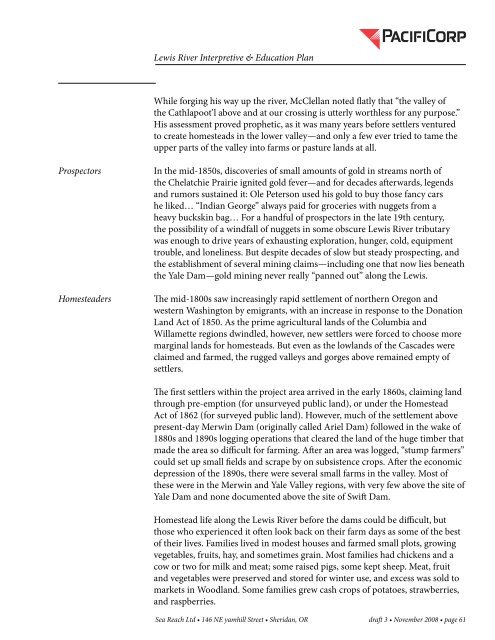The Lewis River Hydroelectric Projects - PacifiCorp
The Lewis River Hydroelectric Projects - PacifiCorp
The Lewis River Hydroelectric Projects - PacifiCorp
You also want an ePaper? Increase the reach of your titles
YUMPU automatically turns print PDFs into web optimized ePapers that Google loves.
<strong>Lewis</strong> <strong>River</strong> Interpretive & Education Plan<br />
While forging his way up the river, McClellan noted flatly that “the valley of<br />
the Cathlapoot’l above and at our crossing is utterly worthless for any purpose.”<br />
His assessment proved prophetic, as it was many years before settlers ventured<br />
to create homesteads in the lower valley—and only a few ever tried to tame the<br />
upper parts of the valley into farms or pasture lands at all.<br />
Prospectors<br />
Homesteaders<br />
In the mid-1850s, discoveries of small amounts of gold in streams north of<br />
the Chelatchie Prairie ignited gold fever—and for decades afterwards, legends<br />
and rumors sustained it: Ole Peterson used his gold to buy those fancy cars<br />
he liked… “Indian George” always paid for groceries with nuggets from a<br />
heavy buckskin bag… For a handful of prospectors in the late 19th century,<br />
the possibility of a windfall of nuggets in some obscure <strong>Lewis</strong> <strong>River</strong> tributary<br />
was enough to drive years of exhausting exploration, hunger, cold, equipment<br />
trouble, and loneliness. But despite decades of slow but steady prospecting, and<br />
the establishment of several mining claims—including one that now lies beneath<br />
the Yale Dam—gold mining never really “panned out” along the <strong>Lewis</strong>.<br />
<strong>The</strong> mid-1800s saw increasingly rapid settlement of northern Oregon and<br />
western Washington by emigrants, with an increase in response to the Donation<br />
Land Act of 1850. As the prime agricultural lands of the Columbia and<br />
Willamette regions dwindled, however, new settlers were forced to choose more<br />
marginal lands for homesteads. But even as the lowlands of the Cascades were<br />
claimed and farmed, the rugged valleys and gorges above remained empty of<br />
settlers.<br />
<strong>The</strong> first settlers within the project area arrived in the early 1860s, claiming land<br />
through pre-emption (for unsurveyed public land), or under the Homestead<br />
Act of 1862 (for surveyed public land). However, much of the settlement above<br />
present-day Merwin Dam (originally called Ariel Dam) followed in the wake of<br />
1880s and 1890s logging operations that cleared the land of the huge timber that<br />
made the area so difficult for farming. After an area was logged, “stump farmers”<br />
could set up small fields and scrape by on subsistence crops. After the economic<br />
depression of the 1890s, there were several small farms in the valley. Most of<br />
these were in the Merwin and Yale Valley regions, with very few above the site of<br />
Yale Dam and none documented above the site of Swift Dam.<br />
Homestead life along the <strong>Lewis</strong> <strong>River</strong> before the dams could be difficult, but<br />
those who experienced it often look back on their farm days as some of the best<br />
of their lives. Families lived in modest houses and farmed small plots, growing<br />
vegetables, fruits, hay, and sometimes grain. Most families had chickens and a<br />
cow or two for milk and meat; some raised pigs, some kept sheep. Meat, fruit<br />
and vegetables were preserved and stored for winter use, and excess was sold to<br />
markets in Woodland. Some families grew cash crops of potatoes, strawberries,<br />
and raspberries.<br />
Sea Reach Ltd • 146 NE yamhill Street • Sheridan, OR draft 3 • November 2008 • page 61
















